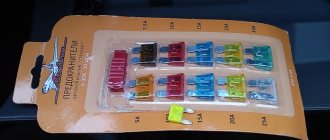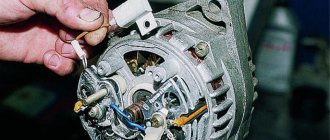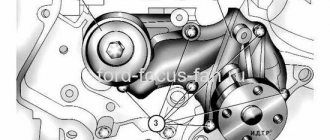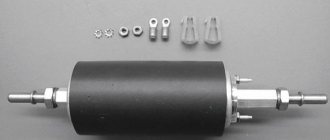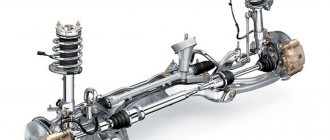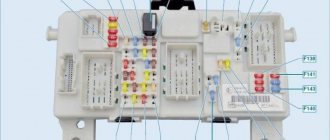Almost all motorists have had problems with their generator. To repair a unit, it is imperative to dismantle the part. The article will tell you what methods there are to remove a generator from a 2nd generation Ford Focus and a 2-liter engine, and we will also describe the process itself.
Video about replacing the generator on a Ford Focus with a 2-liter engine:
Video footage about the process of dismantling the generator from a vehicle. Nuances, subtleties and tricks of the process.
Design features of the Ford Focus 2 generator
On Ford Focus 2 cars, the on-board power supply when the engine is running and the battery is recharged from a three-phase alternating current generator, which is installed on all modifications of this car.
The conversion of alternating current into direct current is carried out by a rectifier unit included in the design of the generator, and stabilization and maintenance of the voltage at the desired level is carried out by an electronic voltage stabilizer.
In addition, the operation of the unit is affected by the power plant ECU. This allows you to adjust the functioning of the generator under different conditions.
It is driven by the crankshaft of the power plant through a belt drive, which is also used to drive other attachments (air conditioning). The unit is cooled by an impeller mounted on the rotor.
The generator for Ford Focus 2 is considered maintenance-free due to the use of sealed bearings on the rotor, the service life of which is designed for the entire period of operation of the car.
In reality, the device is not highly reliable and breaks down quite often.
Duratec engines
Duratec series gasoline engines have been produced by Ford since 1993. The engines are four- and six-cylinder; the Ford Focus-2 is equipped with a 1.4/ 1.6/ 1.8/ 2.0/ 2.5 liter internal combustion engine. The most common types of engines are with volumes from 1.6 to 2.0 liters; hydraulic compensators are not provided for internal combustion engines; the valves are adjusted by selecting the thickness of the washers located in the pushers between the camshaft and the valve itself.
The 16-valve Duratec is a four-cylinder, in-line engine with a fuel injection system, a timing chain, a factory-set service life of 250 thousand km, but in practice the engine lasts longer. Ford passenger cars are also equipped with this power unit:
The engine is also installed on Mazda 2, Volvo C30 and S40. The biggest drawback of the Duratec 1.6 is its low power, this is especially noticeable when equipped with an automatic transmission and air conditioning.
The Duratec HE 2.0 and 1.8 engines are very similar in design, they differ only in the diameters of the cylinders and pistons. The two-liter internal combustion engine is a more profitable option compared to the 1.8 - with almost the same fuel consumption, the two-liter engine is more powerful and runs quieter. The manufacturer's service life is 300 thousand km, but in some cases the engines can run up to half a million kilometers.
Valves on internal combustion engines of the Duratek series are supposed to be adjusted after 150 thousand km, the timing chain life is over 200 thousand km. The engine oil is changed after 10-15 thousand, the air filter - after 15 thousand kilometers.
Node malfunctions
Symptoms of a malfunction are:
- Increased noise from under the hood (squealing, squeaking);
- No battery recharging;
- Lack of electricity when using the car’s electrical equipment (the headlights shine dimly, and when they are turned on, the warning lights on the dashboard dim).
At the same time, despite the fact that the generator is connected to the self-diagnosis system, a fault signal is not always displayed on the on-board computer. In this case, the breakdown can be identified experimentally.
Functionality check
Before removing the generator from the Ford Focus 2 for replacement or repair, you should first verify that it is faulty. The verification technology is very simple and fast.
Before diagnosing performance, it is necessary to loosen the positive terminal on the battery.
And then we do this:
- start the engine;
- wait until the speed stabilizes;
- turn on the headlights;
- With the engine running, remove the positive terminal from the battery.
If the generator is working properly, the power plant should not stop; on the contrary, its speed should increase slightly, since the ECU will adjust the operation of the motor to provide the on-board network with energy.
Stopping the unit after removing the terminal will indicate a malfunction of the generator and the need for its repair or replacement. And to do this, the unit needs to be removed from the car, which turns out to be not so easy.
You can use the official instructions, which are presented below, but it does not reflect all the subtleties and nuances of the work, and therefore is more suitable for familiarization than as a detailed guide that everyone can understand.
Replacing the brush assembly
The most common failures for which the generator has to be removed are wear of the graphite brushes and rotor bearings. These faults can be classified as mechanical and you can fix them yourself.
To replace the brush assembly, you only need 8 and 10 wrenches, as well as a flathead and Phillips screwdriver.
The brush assembly is located under the rear cover, and complete disassembly of the generator is not required. To replace the brushes, you need to remove the back cover, and to do this:
- Unscrew the second nut on the stud to which the power cable is connected;
- Using a size 8 wrench, twist the three nuts securing the cover;
- Using a screwdriver, unscrew the terminal jumper screw;
- Remove the cover.
After dismantling the cover, all that remains is to unscrew the three screws of the brush assembly, remove it, install a new one and put everything back together.
The entire work process is described in the official instructions.
In addition to the brushes, by removing the back cover you can also change the voltage regulator and rectifier bridge.
As for the bearings, to replace them you will have to completely disassemble the unit.
Malfunctions related to the electrical part - breaks in the windings, short circuits and other breakdowns - can only be repaired by a specialized service center.
In some cases, such faults cannot be eliminated and the generator is simply replaced with a new one.
Source
Step-by-step instruction
You can replace, put on and tighten the product yourself.
Required Tools
We change the belt after all the tools have been collected:
- set of wrenches;
- dressing device;
- tensioner;
- Screwdriver Set;
- jack;
- rollers.
A device for putting on can be purchased in a store, rented at a service station, or developed a drawing and made yourself. The donning tool will allow you to complete the installation procedure faster, and rollers will be required if the old parts have begun to wear out.
User Ernest told how to change the alternator belt yourself.
Replacement steps
To properly remove, install and tension the drive belt of the generator set and air conditioner, you must proceed according to the following scheme:
Replacing the Ford Focus alternator belt is performed by dismantling the product. To do this, remove the key from the car's ignition and open the hood. Unscrew the screws securing the terminals connected to the battery, and then remove them. Loosen the screws that secure the front right wheel. Place this part of the car on a jack. Unscrew the screws completely and remove the wheel. After removing the wheel, you can remove the fender liner. Disconnect and move the mudguard aside. Once you have access to the generator belt, remove it. To do this, use a previously prepared knife. After cutting and dismantling the belt, clean the shaft surface. Visually assess the condition of the installed rollers. If there are defects, parts must be replaced. Now you need to install a new belt and tighten it. The strap should be positioned centrally between the hydraulic power steering pump and the crankshaft. You will see the pump wheel; a tool for installing the part is mounted on it. Once the tool is installed, it should be turned counterclockwise. You need to put the belt on the drive pulley. It is mounted in such a way that the number located on the surface is directed towards the machine motor. The belt is installed on the shafts of the hydraulic booster, air conditioning system and generator unit. The product is tensioned. Use a 19 key to turn the water pump pulley
The procedure is performed carefully. While the pulley is spinning, the belt is tensioned
Scrolling is carried out until the belt stretches and sits fully on the pulley. Take an 18mm wrench and use it to turn the crankshaft a few turns. As a result, you can check the correct installation of the part. To tighten the belt on the compressor drive of the Conder, place the installation tool on the pulleys of the auxiliary devices. Installation is carried out in such a way that the tool is located between the axes of the pulley. The device is placed on the device and installed on the compressor shaft. The crankshaft turns again. This is done until the product is completely seated on all the shafts. If you manage to do this, then the installation device is removed and the crankshaft is rotated 2-3 turns. Check whether all steps have been performed correctly and evaluate the quality of the product tension. If the tension is insufficient or too strong, the strap may wear out quickly. After installation, make sure that the grooves of the product are correctly installed in the notches on the shaft. Otherwise, the strap may become distorted when starting the engine, which will also lead to wear and breakage. Reassemble everything in reverse order. Reinstall the wheel arch liner and wheel and tighten the bolts securely. Start the engine and check that the belt is working correctly. At first, it may make noise that is uncharacteristic of its operation. Subsequently, the sounds will disappear when the belt gets used. You can use a special softening agent, sold at any automotive chemical store. It helps get rid of extraneous sounds.
Removing a generator for replacing a Ford Focus 2 with a two-liter engine
Almost all motorists have had problems with their generator. To repair a unit, it is imperative to dismantle the part. The article will tell you what methods there are to remove a generator from a 2nd generation Ford Focus and a 2-liter engine, and we will also describe the process itself.
Video about replacing the generator on a Ford Focus with a 2-liter engine:
Video footage about the process of dismantling the generator from a vehicle. Nuances, subtleties and tricks of the process.
Required Tools
To repair and replace the generator, you need the tools listed below.
Table - List of necessary tools for replacing the generator
| Name | Note |
| open-end wrench | “at 8”, “at 15”, “at 19” |
| Head | “at 15”, “at 17” “at 24”, “at 10”, “at 13”, “at 7” |
| Puller | For bearings |
| Vorotok | With ratchet |
| Penetrating lubricant | For example, VD-40 |
| Rags | For cleaning the work surface |
Generator replacement process
Marking of the Desno generator.
Dismantling the generator from a Ford Focus II 2.0 can be done in two ways. The first option is the simplest. It involves removing the product from below, but a pit or lift is required. If there is neither one nor the other, then a more difficult method comes into force - dismantling the assembly through the top.
Part selection: original and analogues
The choice of a generator for a car should be taken more than seriously. The quality of the product will determine how stable the battery power will be, as well as the voltage of the on-board network. For Ford Focus 2, in addition to the original, there are several analogues that can be installed on a vehicle.
Original
All second Focuses with a 2-liter engine were equipped with Denso generators with catalog number 30667071. The average cost of a product in the Russian Federation is about 20,000 rubles.
Analogue
Often when replacing a generator, 120 A is installed instead of the original 105.
In addition to the original, on the automotive spare parts market you can find a fairly large number of analogues that can easily be mounted on a car. So, let's look at the main ones:
| Manufacturer's name | Catalog number | Cost in rubles |
| DENSO | DAN1016 | 16 000 |
| DENSO | 1042103542 | 18 000 |
| FORD | 1530299 | 29 000 |
| FORD | 1748625 | 20 000 |
| WAI | 23839N | 13 000 |
| DENSO | 1042103761 | 15 000 |
| FORD | 1530299 | 27 000 |
Engines
Focus 2 received the latest Duratec series gasoline engines with a new gas distribution system that provides high performance and efficiency. These engines are 1.4 (80 hp), 1.6 (115 hp), 1.8 (125 hp) and 2.0 (145 hp). It was possible to purchase a version with the old reliable 1.6 l / 100 hp engine. Zetec series.
New engines, thanks to modern technologies, turned out to be quite high-torque, but some of them caused trouble. However, their share is not high. The main problem, characteristic of all engines of the new series, turned out to be electronics. The main complaints are floating idle speeds and dips in traction during intense acceleration. The reason lay in errors in the ECU mixture formation program, coils, connectors and ignition wires, as well as in the throttle valve. Electronics sometimes began to malfunction after 30-40 thousand km.
The Duratec series engines are, in addition, very sensitive to the quality of the fuel and the serviceability of the spark plugs. This, in turn, often leads to interruptions in engine operation, detonation and difficult starting in the cold season.
Some engines completely failed even after a mileage of 40-70 thousand km due to oil starvation caused by a faulty oil pump. As a rule, the pressure relief valve jammed. The first sign of the disease is a short blinking of the oil can and a leak of the crankshaft oil seal.
If you do not pay attention to this and delay visiting a car service center, you may find yourself stuck for a long time due to the engine jamming. The luckier ones will simply lose compression, but the verdict will be the same - cranking of the liners
With a mileage of more than 80-100 thousand km, owners complained about an increase in oil consumption - about 100-150 g per 1000 km. By 250-300 thousand km, appetite sometimes increased to 1 liter per 1000 km, which is not the norm. It's all about the underlying rings. The cost of major repairs will be 20-60 thousand rubles.
After 100-150 thousand km, the valve cover gasket may leak. The starter and generator begin to mope after 150-200 thousand km. By this time, the supports of the power unit also wear out (3-5 thousand rubles apiece). After 200,000 km, the fuel pump fails.
Ford Focus 2 engines are not equipped with hydraulic compensators, and therefore the manufacturer recommends adjusting the valve clearance every 150,000 km. The process is quite labor-intensive and requires considerable costs. Some vehicles require valve adjustment after 100,000 km.
Engines of 1.8 and 2.0 liters have a timing chain drive with a declared service life of 300-350 thousand km. There are practically no problems with the timing drive up to 200-250 thousand km. Engines with a capacity of 1.6 and 1.4 liters are equipped with a timing belt drive with a recommended replacement interval of 150,000 km. Mechanics advise reducing it to 100,000 km. The cost of a new kit including work is about 9,000 rubles.
In 1.6/115 hp engines assembled before 2007, camshaft gears often failed. Later the gears were modified and became more durable. The cost of one gear is 5,000 rubles.
Fuel consumption is not a costly aspect of operation. It directly depends on the driver’s temperament and corresponds to the characteristics of the engine. For a 2-liter engine, on average, in the city it is 12-13 liters with a manual transmission and 12-14 liters with an automatic transmission, and on the highway it is content with 7-8 liters. The 1.8 version consumes about 10-11 liters in the city and up to 8 liters on the highway. The 1.6-liter modification requires up to 13 liters in the city with automatic transmission and up to 11-12 liters with manual transmission, and about 7 liters on the highway. The smallest 1.4-liter block is close in gasoline costs to 1.6 liters: up to 11-12 liters in the city and 6-7 liters on the highway.
Diesel versions have not received widespread distribution. The reason is poor fuel quality, which affects the longevity of the injectors, and the fear of the owners. There is a joke among people: “Diesel loves service, but there is no service.” One of the disadvantages is the failure of the glow plug sensor. As a result, the electronics “hold” the spark plug longer than the calculated time, and it burns out. When the mileage exceeds 100,000 km, the EGR valve fails.
In the 1.8 TDCi turbodiesel, the dual-mass flywheel wears out quite quickly - after 80-120 thousand km (20-26 thousand rubles). There are also problems with the turbine (110,000 rubles). If you refuel at trusted places, then the injectors (22,000 rubles apiece) will last more than 200,000 km, and the fuel injection pump (70,000 rubles) will last more than 300,000 km.
Diesel, unlike its gasoline counterparts, is more economical - up to 10 liters in the city and 6 liters on the highway.
Reasons for dismantling the generator
When all the issues related to the dismantling and selection of a generator for a Ford Focus 2 have been considered, it is worth considering the reasons why a motorist will have to remove the part from the vehicle:
- For generator repair.
- To restore auxiliary nodes that the node does not provide access to.
- To carry out repair and restoration work and major engine overhauls.
- Repair of body parts that require removal of the generator.
- For diagnostics and repair of electrical circuits of the on-board network.
conclusions
Removing a generator from a Ford Focus II 2.0 is a simple and, at the same time, complex procedure that requires knowledge of the design features of the engine and the engine compartment. Therefore, not every motorist will be able to cope with the process. Therefore, it is recommended that if difficulties arise, you contact a car service center.
Particular attention should be paid to the selection of parts, since the performance and normal functioning of the on-board network depends on the quality of the product. In addition to the original spare part, there are a number of analogues that can be installed on a car.
Source
Interior
Trends in the use of interior trim materials have not bypassed the Ford Focus II. In general, they make a good impression, but their low quality is revealed by multiple creaks that appear with the onset of cold weather. The most common problems are dashboards and door trims. Sometimes extraneous sounds are made by moldings and the interior lining of the trunk. Noise insulation is average, but the wheel arches are the worst insulated. The front seats often squeak, and with a mileage of more than 50,000 km, the seat height adjustment mechanism sometimes fails when used frequently.
After 150-200 thousand km, from time to time the display on the dashboard begins to malfunction, system malfunction indicators light up, and random error messages appear. The reason is a burnt out processor or bad contacts (needs to be soldered).
